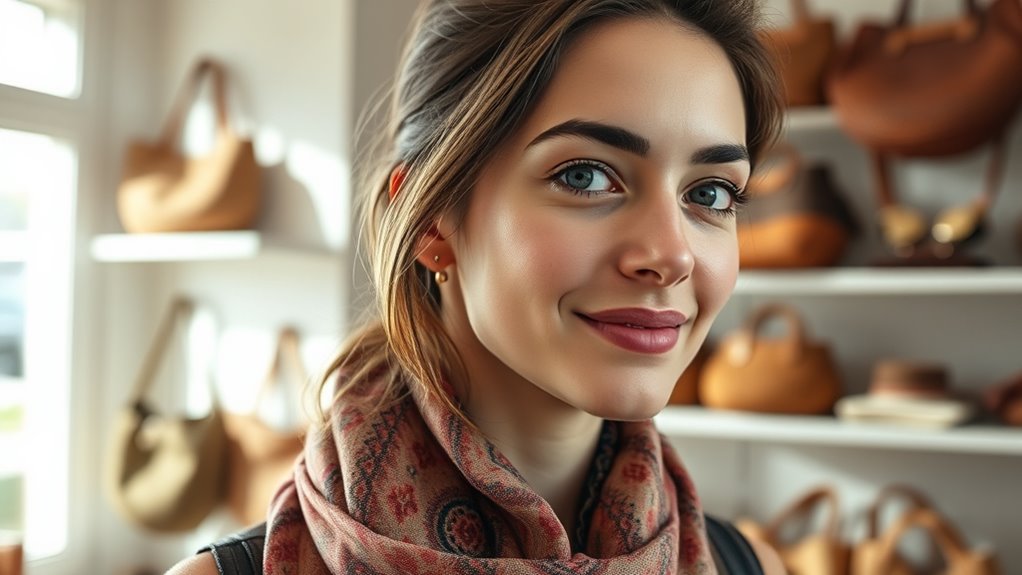Micro-influencers have a powerful impact on niche fashion by connecting specific audiences with authentic and sustainable styles they often can’t find through mainstream channels. They highlight eco-friendly brands, vintage pieces, and unique looks, making these options more accessible and appealing. Their genuine recommendations build trust and encourage conscious shopping. As they foster communities focused on sustainability and vintage fashion, they inspire meaningful change. To discover how they shape the future of fashion, keep exploring these dynamic voices.
Key Takeaways
- Micro-influencers connect niche audiences with authentic, targeted recommendations on sustainable and vintage fashion.
- They promote eco-friendly brands and practices, raising awareness about ethical sourcing and sustainable textiles.
- Micro-influencers curate and showcase rare vintage pieces, encouraging eco-conscious shopping and unique style.
- They foster engaged communities around niche interests like sustainability and vintage fashion, inspiring collective action.
- AI-driven content analysis helps micro-influencers identify trending eco-friendly brands and vintage finds, maintaining relevance.

In the rapidly evolving world of fashion, micro-influencers are making a significant impact by connecting with highly targeted audiences. Unlike traditional celebrities or large influencers, these smaller voices often have followers who are genuinely passionate about niche topics, making their recommendations powerful and authentic. If you’re exploring unique styles or seeking sustainable options, micro-influencers can guide you toward brands that prioritize sustainable materials and rare vintage pieces. Their content often showcases how these items can be integrated into everyday fashion, making sustainability and uniqueness accessible and appealing.
Micro-influencers connect niche audiences with sustainable fashion and rare vintage styles, making authenticity and eco-conscious choices accessible.
As someone interested in eco-conscious fashion, you’ll find that micro-influencers tend to focus heavily on sustainable materials. They highlight brands that use organic cotton, recycled fabrics, or innovative eco-friendly textiles, helping you discover ways to reduce your environmental footprint without sacrificing style. These influencers often share behind-the-scenes looks at how garments are made and emphasize the importance of transparency in sourcing. Their genuine enthusiasm for sustainable fashion encourages you to make more conscious choices, whether it’s opting for a linen shirt or a pair of shoes made from recycled ocean plastics. By following their recommendations, you gain insight into brands that prioritize ethical production, making your shopping more sustainable.
Micro-influencers also excel at curating rare vintage pieces that stand out from mass-produced fashion. If you love hunting for unique items, they often showcase hidden gems from thrift stores, vintage markets, or specialized online shops. Their expertise helps you identify authentic vintage gear and understand how to style these rare finds to create distinctive looks. Through their posts, you learn how vintage pieces can be both eco-friendly and fashionable, breathing new life into old garments and reducing textile waste. This focus on rare vintage not only supports sustainable fashion but also allows you to build a wardrobe filled with one-of-a-kind items that reflect your personality.
What sets micro-influencers apart is their ability to create a sense of community around niche interests. As you follow their content, you feel connected to a group that values authenticity, sustainability, and individuality. They often engage with their audience by sharing tips on caring for vintage clothing or explaining how sustainable fabrics are made, making their advice practical and trustworthy. By tapping into these micro-communities, you gain access to insider knowledge that can elevate your style while aligning with your values. Their influence proves that you don’t need a massive following to make a real impact—sometimes, a small voice with a focused message can inspire meaningful change in your fashion choices. Additionally, leveraging AI-driven content analysis can help identify trending sustainable brands and vintage finds, enabling you to stay ahead in eco-conscious fashion.
Frequently Asked Questions
How Do Micro-Influencers Build Trust With Their Niche Audience?
You build trust with your niche audience through authentic storytelling that resonates with their values and interests. By sharing genuine experiences and showcasing real results, you make your content relatable. Community engagement is key; responding to comments, asking for feedback, and participating in conversations makes your followers feel valued and connected. This consistent, honest approach helps establish credibility and deepens trust, turning followers into loyal supporters.
What Are the Best Platforms for Niche Fashion Micro-Influencers?
Oh, so you’re wondering where to shine in niche fashion? Well, platforms like Instagram and TikTok are your best bets, thanks to their visual platform features and high engagement strategies. They let you showcase your style and connect directly with your audience. You’ll find that niche communities thrive here, making it easier to build authentic relationships and boost your influence—because, let’s face it, fame isn’t just about followers.
How Can Brands Identify Authentic Micro-Influencers?
To identify authentic micro-influencers, you should prioritize brand authenticity and thorough influencer vetting. Look for individuals whose content genuinely aligns with your brand values and resonates with your target audience. Review their engagement rates, previous collaborations, and audience comments to gauge authenticity. You can also use specialized tools to analyze follower authenticity and guarantee their influence is genuine, helping you build trust and credibility in your niche market.
What Are Common Challenges Faced by Niche Fashion Micro-Influencers?
You might face challenges like securing consistent brand partnerships, which can be unpredictable, and maintaining content consistency to keep your audience engaged. Juggling multiple collaborations without sacrificing your authentic voice can be tough. You may also struggle with growing your niche audience and standing out among competitors. Staying true to your style while meeting brand expectations requires effort, but it’s essential to build trust and long-term success in niche fashion.
How Do Micro-Influencers Measure Their Campaign Success?
Did you know that 70% of micro-influencers track engagement metrics to measure success? You should focus on engagement metrics like likes, comments, and shares to see how your audience interacts with your content. Additionally, monitoring conversion rates helps you understand how many followers take action, like making a purchase. By analyzing these data points, you can refine your strategies and boost your campaign effectiveness.
Conclusion
You can see how micro-influencers hold real sway in niche fashion, with studies showing they generate 60% more engagement per post than larger influencers. Their authentic connections and specialized content truly resonate with passionate audiences. So, if you’re looking to boost your brand’s visibility in a specific market, partnering with these relatable, niche-focused voices could be your game-changer. Don’t underestimate the power of micro-influencers—they might just be your secret weapon.







